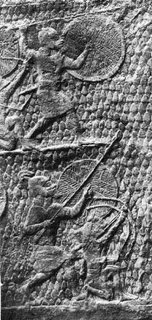I had a free half-day in London yesterday and decided to pay the British Museum a rather overdue visit (I think it's been 10 years since the last time). Not having too much time, I headed straight for the Ancient Far East rooms, which I remembered as being pretty impressive from my last visit. As it turned out, I spent most of my time in and around the "Lachish" and the "Nineveh Palace" rooms, displaying items excavated in and around modern-day Iraq from the Sennacherib period. Sennacherib, king of Assyria in the 8th century BCE, is mentioned in the Bible and in the Talmud as the evil king from the North that descended upon Judah to try and quench the rebellion of the Jews in the times of king Hezekiah (helped by the Egyptians). He succeeded in conquering the city of Lachish, south-west of Jerusalem, but despite a long siege could not take Jerusalem and returned to his city of Nineveh. The Bible attributes this failure to a divine intervention: the angel of God descended upon Sennachrib's camp and killed 185,000 men (Melachim Bet). The Assyrian chronicles, on display at the British Museum, obviously tell a different story: Hezekiah was forced to surrender and to pay large sums of money to Sennacherib, and this is why the Assyrian king retreated back to his kingdom and spared the city.
As it turned out, I spent most of my time in and around the "Lachish" and the "Nineveh Palace" rooms, displaying items excavated in and around modern-day Iraq from the Sennacherib period. Sennacherib, king of Assyria in the 8th century BCE, is mentioned in the Bible and in the Talmud as the evil king from the North that descended upon Judah to try and quench the rebellion of the Jews in the times of king Hezekiah (helped by the Egyptians). He succeeded in conquering the city of Lachish, south-west of Jerusalem, but despite a long siege could not take Jerusalem and returned to his city of Nineveh. The Bible attributes this failure to a divine intervention: the angel of God descended upon Sennachrib's camp and killed 185,000 men (Melachim Bet). The Assyrian chronicles, on display at the British Museum, obviously tell a different story: Hezekiah was forced to surrender and to pay large sums of money to Sennacherib, and this is why the Assyrian king retreated back to his kingdom and spared the city.
Most of the reliefs in the Niniveh Palace room are partial, but the battle scenes they depict are still grandiose. Even more astounding are the reliefs in the Lachish room. One of the more interesting reliefs shows prisoners of war being brought before Sennacherib, who is sat on a throne and sentences some of them to death. Interestingly, the relief is almost intact and spans across an entire wall, but the king's face was deliberately defaced, probably after the end of his reign, when Nineveh fell in 612 BCE.
Now I need to visit the site at Nineveh, where apparently the Iraqi department of Antiquities did a fabulous job of preserving the excavated remains of Sennacherib's palace.



No comments:
Post a Comment